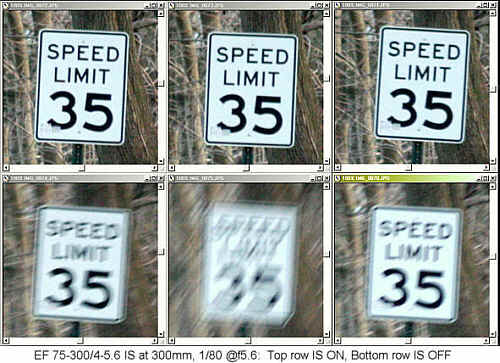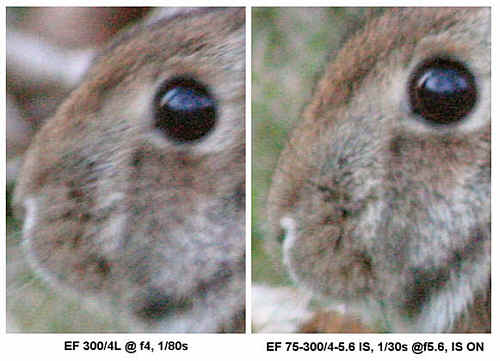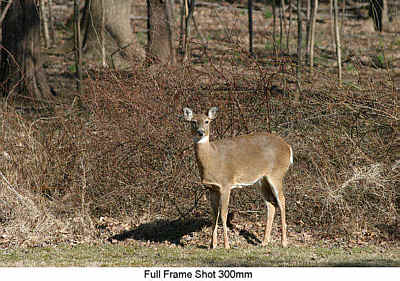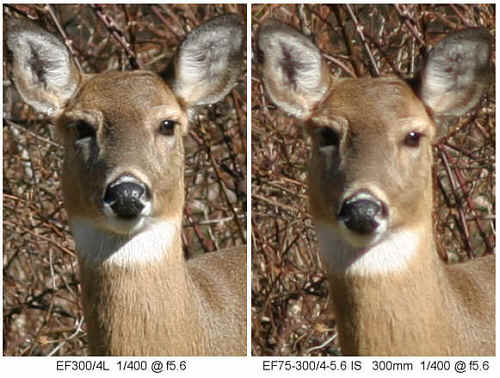
|
IS - does it work? Is it worth it?One of the most popular questions asked on web photography forums is some variation on "what should I buy" and "Is it worth it". This article addresses some aspects of the issues of which 300mm lens to buy and whether IS is worth it! For those who don't know about IS lenses, they contain small gyro sensors and servo actuated optical elements which correct for camera shake and thus stabilize the image and give higher sharpness then you'd otherwise get. While not as good as a tripod, they allow a lens to be handheld at 2-3 stops slower shutter speeds than the minimum required for sharp images with non-IS lenses. At least that is the claim to be tested. Is it worth an extra $200 to upgrade from a Canon EF75-300/4-5.6 lens to the EF75-300/4-5.6 IS version? Is it worth the extra $400 to upgrade the EF75-300/4-5.6 IS to an EF 300/4L (used, since it's not made anymore) or $700 to upgrade to a 300/4L IS lens? I'm not going to directly answer that question because "worth it" is a highly subjective condition. It depends a lot whether $700 if your life savings or the amount you'd normally spend on a meal and a bottle of wine. However I will present some images which might help YOU to make up YOUR mind on the issue and show if IS really does work. So let's start off with a shot taken on a typical New Jersey suburban street!
Above is a full frame shot with a street sign centered. I shot three frames with IS on and 3 frames with IS off, and the results are shown below:
Pretty clear that IS works! The top row of images, shot with IS on, are consistantly sharp. The bottom row of images, shot with IS off, demonstrate that I can't hold a 300mm lens steady enough at 1/80s to give a sharp image. Some shots are better, some are worse, but they all show significant blurring. Below is a shot of a cooperative rabbit in my garden. This was for a comparison of a 300/4L prime lens and the 75-300/4-5.6L, hand held in low light. The ISO setting on the 10D was ISO 3200. The shutter speed was 1/30s with the 75-300 wide open at 300mm (f5.6) and 1/80s with the 300/4L wide open (f4), so the "L" prime had a 1.3 stop advantage. Would this be enough to make the "L" images better than the IS images?
Below are two typical frames. The noise is due to the ISO 3200 setting. As you can see, the IS image is sharper than the 300 "L" series non-IS lens image. Note that I did say "typical" frames. If you shoot enough frames, some will be less sharp, but some will be sharper. If you shot 10 frames with the "L" lens, it's quite possible that one of them would be better than anything you could get with the IS lens, though 2 of them might be similar and 7 of them might be worse! Shoot enough frames hand held at almost any reasonable speed and sooner or later you'll get a sharp one.
While I think the above images have addressed whether IS works (it does) and whether and IS lens can beat and "L" series lens in actual use under some conditions (it can), there remains the question of just how much image quality you lose going from an EF 300/4L to a 75-300/4-5.6IS under good conditions where the IS function does not come into play. The images below answer that question. They were taken using an EOS 10D at ISO 100 with the camera/lens mounted on a sturdy tripod (Bogen 3051) using a sturdy ballhead (Arca Swiss B1), with a shutter speed of 1/400s and an aperture of f5.6. IS was not used. The deer was in my garden and was highly cooperative, since it stood there motionless (the rabbit moved a bit..) and stared at me while I switched lenses!
Above is the full frame shot. It happens to have been taken with the 75-300IS, but at this scale the image from the 300/4L would look identical. The more interesting images are below
You can see from the above shots that the image from the 300mm prime "L" series lens is sharper. Significantly more detail is visible in the fur. Contrast is higher (blacks are blacker). This isn't a matter of one being in better focus either. Repeat shots looked the same and from the foreground/background detail in each image it was evident that focus was the same for both lenses. This is pretty much the expected result. The image quality of an $800 "L" series prime lens (or $1100 "L" Series IS lens) is better than that of a $450 consumer zoom IS lens (or the equivalent $200 consumer non-IS zoom lens). Not a big surprise. For the web (see the small full frame shot above), the difference doesn't matter, but once you start cropping the image significantly or making large prints, the difference becomes more important. The difference is larger at the edges of the frame, where the 75-300 becomes softer and shows more chromatic aberration. It it "worth it" to spend $600-$700 for this difference? Only you know the depth of your wallet. If you mostly make 4x6 prints or 5x7 prints, you probably don't need the "L" lens. If you make 8x10 prints you'll probably see the better quality of the "L" images, and if you make 11x14 prints, you will almost certainly want the better and more expensive lens. The "L" lens is also nicer to use, has smoother focus, a tripod ring, a built in lens hood, doesn't rotate or extend duing focus and is a stop faster. All these things come into play along with image quality when answering the "is it worth it" question. The one stop faster speed means you can shoot with a shutter speed twice as fast. This means nothing with a static subject, but if your subject is moving, you want a fast shutter speed and IS won't help here. Of course the 75-300 also covers the 75-299mm range that the 300mm prime doesn't, plus it's smaller and lighter. More factors to consider when asking the "worth it" question. There are reviews of the various x-300 zooms, the 3004L and 300/4L IS and a preview of the new 70-300 DO IS lens in the REVIEWS section of this website. ConclusionThe conclusion is that IS works. With the 75-300/4-5.6 IS lens, you probably gain at least 2 stops, probably three stops, of hand holdability. Under the lowest light conditions, the consumer zoom IS lens can outperform an "L" series non-IS lens (though it wouldn't beat the 300/4L IS lens!). On a tripod, the "L" lens is a clear winner, but for web images the difference will most likely not be visible. If you're shooting action, IS won't help. It stabilizes the lens and allows shooting at slower shutter speeds. Fast action needs a fast shutter speed, which means a fast lens.
© Copyright Bob Atkins All Rights Reserved |
|





